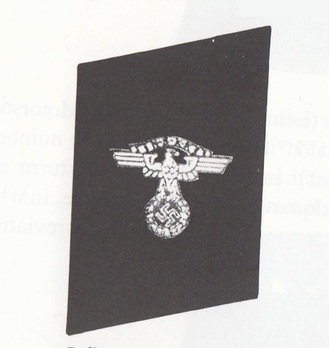NSKK Wartime Military-Attached Units Collar Tabs
CATEGORY: Version
SKU: 53.GOR.03.02.02.02.02.013.000
Estimated market value:

Estimated market value:
The NSKK (Nationalsozialistisches Kraftfahr-Korps = National Socialist Motor Corps) was a paramilitary organisation affiliated with the NSDAP, specialising in anything related to the driving of motorised vehicles. NSDAP officials recognised the need for access to cars and trucks for both transportation and propaganda purposes as early as 1922, and certain steps were taken to ensure this need was met. However, it took until April of 1930 for a specialised motor organisation to be officially founded. This organisation was named NSAK (Nationalsozialistisches Automobil-Korps = National Socialist Automobile Corps), but was renamed to NSKK less than 13 months later.
Initially, the NSAK/NSKK was under the control of the SA and existed next to its parent organisation’s own driving-related sub-organisation, the Motor-SA. This changed after the “Night of the Long Knives”, in which many SA leaders were purged and the organisation was substantially disempowered. After July of 1934, the NSKK became an independent organisation whose leader, NSKK-Korpsführer Adolf Hühnlein, answered directly to Adolf Hitler.
The main tasks of the NSKK were to provide transportation for all organisations of the Third Reich, to train and instruct boys and men (and a number of women) in mechanics and driving, and to assist police in regulating traffic. During the mid 1930s, the organisation also provided roadside assistance.
With the onset of the war, the NSKK’s tasks underwent certain changes. Instructing both civilians and soldiers in the driving and maintenance of armored vehicles became a higher priority. The NSKK also began working closely with other organisations, for example Organisation Todt (OT), by providing transportation of workers and supplies for the colossal building project that was the fortification of Germany’s Western border, the Siegfried Line (or Westwall). During the war, the NSKK provided much of the transportation needs for the German Army and the Luftwaffe, including the transport of troops, weapons and ammunition, and building materials, for example for the construction of air bases in the newly conquered territories in Eastern Europe after the attack on Soviet Russia in the summer of 1941.
Parts of the NSKK would come under the control of architect Albert Speer who took over OT after the death of Fritz Todt in 1942, leading to the creation of Transport Brigade Speer (later Transport Corps Speer), which would eventually completely sever its ties to the NSKK.
The NSKK used the same pattern of rank collar tabs as the SA.
NSKK collar tabs are generally black in colour, although there are a few exceptions. Corps and group leaders wore carmine collar tabs and the staff members of certain motor groups wore vermilion collar tabs.
The higher leader ranks above Staffelführer were issued collar tabs that were piped with 1.5-2mm of twisted aluminium cord. The ranks below Staffelführer were issued collar tabs that were not piped.
The ranks of Standartenführer and above wore rank collar tabs on the left and right side of the collar. Ranks below Standartenführer wore a rank collar tab on the left side and a unit collar tab on the right side.
Matte silver letter and number cyphers were affixed to the front of the collar tabs to denote the wearer’s unit. The numbers are around 11mm high, the upper case letters are around 16mm high, and the lower case numbers are around 11mm high. The cypher can be hollow or solid, and the solid versions are usually stamped with an RZM control number on the reverse.
Unit collar tabs of the NSKK can be divided into Korpsführung (corps leadership, including corps headquarter members and corps staff) motor groups.
Members of those NSKK units that were attached to the armed forces during the war wore an NSKK-style eagle emblem cypher on their black collar tab. The eagle has been found positioned both vertically or horizontally. This collar tab was most often worn by non-German volunteers.

Comments
Sign in to comment and reply.


Scroll Top